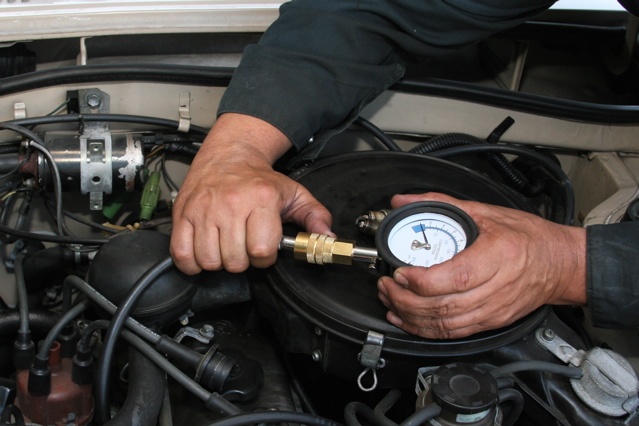Do You Need a Compression Test?
Your car’s engine compression can tell you a lot about the overall health of the engine. If your car is blowing blue smoke out of the tailpipe, or if your car is losing lots of oil, you could have a bad piston ring. This will also cause low compression in that cylinder, and a compression test will tell you. The same goes for a bad valve. Even if you are just noticing a general lack of power, a compression test can help you rule out some of the more serious possible causes.
*Note: This test was performed on an ancient Porsche engine to demonstrate the basics of how a compression test works. Please consult your repair manual for specific instructions on your vehicle.
The Compression Testing Kit
To do a compression test, you’ll need to buy (or borrow) a compression testing kit. These can be bought for surprisingly little money from any auto parts store.
What’s in the kit?
Indicator Dial Gauge
Testing Tube
Spark Plug Hole Adapters
That’s it! Does it seem a little easier now? Let’s go do the compression test.
Before You Begin
Before you begin the compression test, the engine needs to be warm. Get the engine up to operating temperature by running it for a while, or you can do your compression test after a drive.
Be careful. Some parts of the engine can be very hot!
You’ll also need to disable your ignition system. We are going to need to crank the starter to turn the engine over but we don’t want it to actually start. In most cars simply disconnect the ECU. If your car has an old school coil like the one pictured above, remove the wire from the terminal marked 15. If your car has a coil pack type distributor less ignition, unplug the coil pack or packs. Please consult your repair manual to find out what’s specific to your vehicle.
Those silver threaded pieces that came with your compression testing kit are adapters. They allow you to have the right clearance and other stuff to properly measure the engine compression in that cylinder.
Remove one spark plug and insert the appropriate testing adapter. A spark plug socket will insert it easily. Tighten it snugly as you would a spark plug, but don’t over tighten it, this can damage your engine.
*Be sure you read the instruction on your compression testing kit and use the correct adapter! Engine damage can result!
Screw in the Testing Tube
With the correct adapter snugly in place, screw the long black testing tube onto the silver adapter. It’s a pain in the neck to screw in, but just keep turning the whole thing like a giant straw until its snug.
Do not tighten the tube with a tool! Hand tight is enough.
Attach the Testing Gauge
With the testing tube firmly seated on the silver adapter, you’re ready to attach the test gauge. The gauge displays engine compression. To install it, pull back the collar at the end of the gauge and slide it over the metal end of the tube. Give it a tug to be sure that it’s on.
Take Your Compression Reading
You’re all set up now and ready to actually
Do the compression test. Double check that you disconnected the appropriate stuff so the engine doesn’t actually start. Now turn the key and crank the engine over for about 10 seconds. The needle on the compression gauge will stay at the highest indicated compression reading. This number indicates the compression for that cylinder only. Record it so that you can compare it to the other readings you’re about to take.
Don’t remove the gauge just yet!
Remove the Gauge and Repeat
Don’t just remove the gauge, there’s a lot of pressure in the line and you want to release it first. Thankfully they thought of this, and there’s a little button on the side. Depress the button and you’ll hear the pressure hiss out. Now it’s safe to remove the gauge, unscrew the testing tube, and take out the adapter.
Replace the spark plug and repeat the whole process on the next cylinder until you have readings for all of them. Check your repair manual to see if the readings you got are healthy.

How to Perform a Compression Test
by
Tags:

Leave a Reply